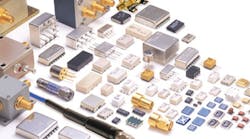This file type includes high resolution graphics and schematics when applicable.
Narrowing and controlling a receiver’s bandwidth could lead to measurable benefits in the dynamic range and sensitivity of microwave receivers. If a 0.5% bandwidth-tunable amplifier achieves that narrow bandwidth without superconductors or cryogenic cooling, for example, it could add a lot of value to systems that couldn’t support the added infrastructure required by such enhancements. This amplifier could be of special interest to designers of electronic-warfare (EW) systems, who struggle to get the most flexibility and operation potential out of a component without increasing complexity or cost. In a five-page white paper provided by Planar Monolithics Industries’ Dr. Alfred Grayzel, Dr. Ashok Gorwara, and Paul Kuhn, such a design is described in detail.
According to the paper, “The Design of Ultra Narrow-band Amplifiers using Small Signal Varactor Up-converters for ESM, ECM, ECCM, and ELINT Applications,” the core of the design is a narrowband negative resistance amplifier. The amplifier is terminated into a varactor-based upconverter for ultra-narrow bandwidths and tunability. The upconverter will image the terminated impedance from the signal frequency to the pumped frequency. If the terminating impedance is negative in nature, it will result in a contraction of the bandwidth related to the pumping frequency versus the signal frequency.
This amplifier could be used in cascaded stages for ultra-narrow-bandwidth operation, as the network would contract the bandwidth at each stage. For example, say a 100-MHz signal is upconverted to 1 GHz and the original bandwidth was 5%. The subsequent upconverted bandwidth using a terminating negative resistance amplifier would be 0.5%. If this output is then connected to another upconverter, which pumps the frequency to 10 GHz, the resulting bandwidth would be 0.05%.
Among the receiver applications that could benefit from this design are instantaneous frequency monitors, direction-finding radar, warning radar, or jammers. The narrowing of the bandwidth would prove an advantage for the receivers, as the lowest-level signal that they can detect is a function of the bandwidth. Enhancing the receiver’s selectivity thus augments its sensitivity, allowing the receiver to detect signals as much as 100 times weaker using the example provided.
Planar Monolithics Industries, Inc., 7311-F Grove Rd., Frederick, MD 21704; (301) 662-5019.
This file type includes high resolution graphics and schematics when applicable.

